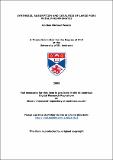Synthesis, adsorption and catalysis of large pore metal phosphonates
Abstract
The synthesis and properties of metal phosphonates prepared using piperazine-based bisphosphonic acids have been investigated. The ligands N,N’-piperazinebis(methylenephosphonic acid) (H₄L), and the 2-methyl (H₄L-Me) and 2,5-dimethyl (H₄L 2,5-diMe) derivatives have been prepared using a modified Mannich reaction. Hydrothermal reaction of gels prepared from metal (II) acetates and the bisphosphonic acids results in the synthesis of four structures: STA-12, Ni VSB-5, Co H₂L.H₂O and Mg H₂L.
STA-12, synthesised by reaction of Mn, Fe, Co or Ni acetate with H₄L or H₄L-Me, has been investigated further. STA-12 crystallises in the space group R⁻₃, and Ni STA-12 is the most crystalline version. Its structure was solved from synchrotron data (a = b = 27.8342(1) Å, c = 6.2421(3) Å, α = β = 90°, γ = 120°), and it has large 10 Å hexagonal shaped pores. Helical chains of Ni octahedra are coordinated by the ligands, resulting in phosphonate tetrahedra pointing towards the pore space. Water is present, both coordinated to the Ni²⁺ cations and physically adsorbed in the pores. Mixed metal structures based on Ni STA-12, where some Ni is replaced in the gel by another divalent metal (Mg, Mn, Fe or Co) can also be synthesised.
Dehydration of STA-12 results in two types of behaviour, depending on the metal present. Rhombohedral symmetry is retained on dehydration of Mn and Fe STA-12, the a cell parameter decreasing compared to the as-prepared structures by 2.42 Å and 1.64 Å respectively. Structure solution of dehydrated Mn STA-12 indicates changes in the torsion angles of the piperazine ring bring the inorganic chains closer together. Fe and Mn STA-12 do not adsorb N₂, which is thought to be due to the formation of an amorphous surface layer.
Dehydration of Ni and Co STA-12 causes crystallographic distortion. Three phases were isolated for Ni STA-12: removal of physically adsorbed water results in retention of rhombohedral symmetry, while dehydration at 323 K removes some coordinated water forming a triclinic structure. A fully dehydrated structure (dehydrated at 423 K) was solved from synchrotron data (a = 6.03475(5) Å, b = 14.9156(2) Å, c = 16.1572(7) Å, α = 112.5721(7)°, β = 95.7025(11)°, γ = 96.4950(11)°). The dehydration mechanism, followed by UV-vis and Infra-red spectroscopy, involves removal of water from the Ni²⁺ cations and full coordination of two out of three of the phosphonate tetrahedra forming three crystallographically distinct Ni and P atoms. No structural distortion takes place on dehydration of Ni and Co STA-12 prepared using the methylated bisphosphonate, and the solids give a higher N₂ uptake as a result.
Dehydrated Ni and Co STA-12 were tested for adsorption performance for fuel related gases and probe molecules. Investigations were undertaken at low temperature with H₂, CO and CO₂, and ambient temperature with CO₂, CH₄, CH₃CN, CH₃OH and large hydrocarbons. Due to the presence of lower crystallinity, Co STA-12 has an inferior adsorption performance to Ni STA-12, although it has similar adsorption enthalpies for CO₂ at ambient temperature (-30 to -35 kJ mol⁻¹). Ni STA-12 adsorbs similar amounts of CO₂ and N₂ at low temperature, indicating the adsorption mechanisms are similar. Also, it adsorbs 10 × more CO₂ than CH₄ at low pressure, meaning it could be used for separation applications.
Ni STA-12 adsorbs 2 mmol g⁻¹ H₂ with an enthalpy of -7.5 kJ mol⁻¹, the uptake being due to adsorption on only one-third of the Ni²⁺ cations. The uptake for CO is 6 mmol g⁻¹, with adsorption enthalpies ranging from -24 to -14 kJ mol⁻¹. This uptake is due to adsorption on all the Ni²⁺, meaning the adsorption enthalpies are high enough to allow the structure to relax. This is also observed for adsorption of CH₃CN and CH₃OH, where there is a return to rhombohedral symmetry after uptake.
The adsorption sites in dehydrated Ni and Co STA-12 were investigated via Infra-red spectroscopic analysis of adsorbed probe molecules (H₂, CO, CO₂, CH₃CN and CH₃OH). The results indicate the adsorption sites at both low and ambient temperature are the metal cations and the P=O groups. The metal cation sites are also characterised as Lewis acids with reasonable strength.
STA-12 was shown to have acidic activity for the liquid phase selective oxidations of 1-hexene and cyclohexene, although there is evidence active sites are coordinated by products and/or solvents during the reaction. STA-12 also demonstrates basic activity for the Knoevenagel condensation of ethyl cyanoacetate and benzaldehyde. Modification of STA-12 by adsorption of diamine molecules causes a slight increase in the basicity, and the highest conversions are where water and diamine molecules are both present.
Type
Thesis, PhD Doctor of Philosophy
Collections
Items in the St Andrews Research Repository are protected by copyright, with all rights reserved, unless otherwise indicated.

